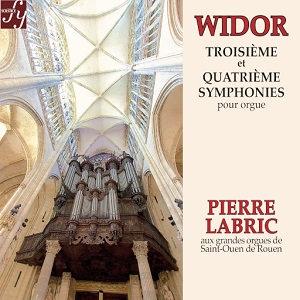
Charles-Marie Widor (1844-1937)
Organ Symphony No 3 in E Minor, Op 13 No 3 (1872)
Organ Symphony No 4 in F Minor, Op 13 No 4 (1872)
Pierre Labric (organ)
rec. 1971, l’abbatiale Saint-Ouen de Rouen, France
Solstice SOCD405 [64]
Pierre Labric (born 30 June 1921) has now reached the remarkable age of 102 years. A brief glance at Solstice’s website provides evidence to the label’s ardent championing of his distinguished discographical legacy. This is the fourth volume in their ongoing Widor Organ Symphony cycle, and reviews of the previous three volumes can be found here (review ~ review ~ review). Surprisingly, Labric’s recorded legacy is confined to a very brief period of some five years (1969-1974). Widor’s masterful ten organ symphonies were recorded on the great Cavaille-Coll Organ of Saint Ouen de Rouen in 1971. They were released on an eleven LP set in the United States by the Musical Heritage Society. These were popular and quickly sold out, and subsequently became the object of pirate transfers. Apparently, the pressings of this American edition were only mediocre. Solstice managed to obtain from a doctor via auction a set of tapes, which are the basis of this new remastering.
Widor composed ten organ symphonies, which span the years 1872-1900. Both Nos 3 and 4 are in minor keys. No. 3 dates from 1872 and was originally conceived in six movements but was eventually reduced to five. It was subsequently revised in 1887, 1901 and 1918. It opens with a magisterial 6/8 Prélude. An enchanting Minuetto follows. Labric paints this is some luminous hues and the effect is gratifying. Rough-hewn grandeur characterizes the Marcia. A bucolic Adagio soothes the senses by factoring in some calm. The finale closes the Symphony with a real sense of epic sweep.
1872 also saw the composition of the Fourth Symphony and this, too, underwent some revisions in 1887, 1901 and 1920. The Symphony is structured in six movements, the first being a grand Toccata. An adeptly drafted four-part Fugue follows. A lyrical third movement resembles a Mendelssonian song without words, and Labric’s choice of registration brings some endearing warmth and intimacy to it. A delicate Scherzo precedes a pastoral Adagio. Energy and unrestrained power are unleashed in the impressive finale.
Pierre Labric proves himself an excellent Widor interpreter. His choice of tempi throughout are ideal. I can only conclude that this is superior music-making.
In the accompanying booklet, François Sabatier discusses the two Symphonies featured in great detail. It’s a pity there’s no profile of Labric himself, though. His choice of the splendid Aristide Cavaillé-Coll organ of Saint-Ouen Abbey, Rouen was very apt. It dates from 1890, and is more or less in its original state today, although some minor restoration work was carried out in 1941 and 1955. The instrument has been captured well in the recording process. It sounds glorious, with clarity of detail and wide dynamic range. The all-important organ specifications are included in the booklet.
Stephen Greenbank
Availability: FY Solstice

















